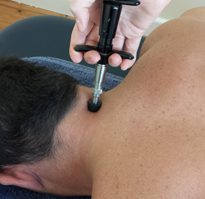Physiotherapy Instrument Mobilisation (PIM)
Article by John Miller

What is Physiotherapy Instrument Mobilisation (PIM)?
Physiotherapy Instrument Mobilisation (PIM) represents a cutting-edge approach in physiotherapy. It uses mechanical, spring-loaded instruments to precisely mobilise spinal and peripheral joints. This method draws on proven physiotherapy techniques like the Nordic concave-convex method by Kaltenborn, Maitland’s integrated movements, Mulligan’s mobilisation strategies, and osteopathic principles.
Physiotherapists trained in PIM leverage these tools within a comprehensive, research-backed treatment plan. They combine palpation skills with neurodynamics and neurological assessments to tailor treatments. PIM offers a dependable, precise, and secure way to mobilise joints, outperforming traditional manual methods in effectiveness.
When to Choose Physiotherapy Instrument Mobilisation (PIM)
If you’re battling persistent pain or joint stiffness and haven’t tried Physiotherapy Instrument Mobilisation, consulting a PIM-trained physiotherapist could be your next step. They can evaluate if PIM might offer relief and assist in your recovery process. It’s important to check that your chosen PhysioWorks clinic has a PIM-trained physiotherapist available.
What to Do?
Facing joint stiffness or pain that won’t go away? It’s crucial to seek professional advice. A physiotherapist trained in Physiotherapy Instrument Mobilisation can assess your situation and determine if this innovative treatment can offer the relief you need.
Recent Research
Recent studies underscore the efficacy of PIM, highlighting its role in reducing pain and improving joint mobility. These benefits are attributed to the precise and controlled application of mobilisation techniques, which target specific areas of discomfort.
Conclusion
Physiotherapy Instrument Mobilisation stands out as a highly effective treatment for those suffering from joint pain and stiffness. By incorporating advanced instruments and methodologies, PIM-trained physiotherapists can offer targeted relief and a path towards improved mobility and comfort.
Related Articles
- Joint Mobilisation Techniques in Physiotherapy – Readers can learn about various techniques used to mobilise joints, similar to PIM.
- Understanding Neurodynamics in Physiotherapy – Since neurodynamics is mentioned in the PIM article, this link would provide readers with a deeper understanding of how it contributes to physiotherapy.
- Advanced Physiotherapy Techniques for Pain Management – An article that discusses various advanced techniques, including PIM, for managing pain.




